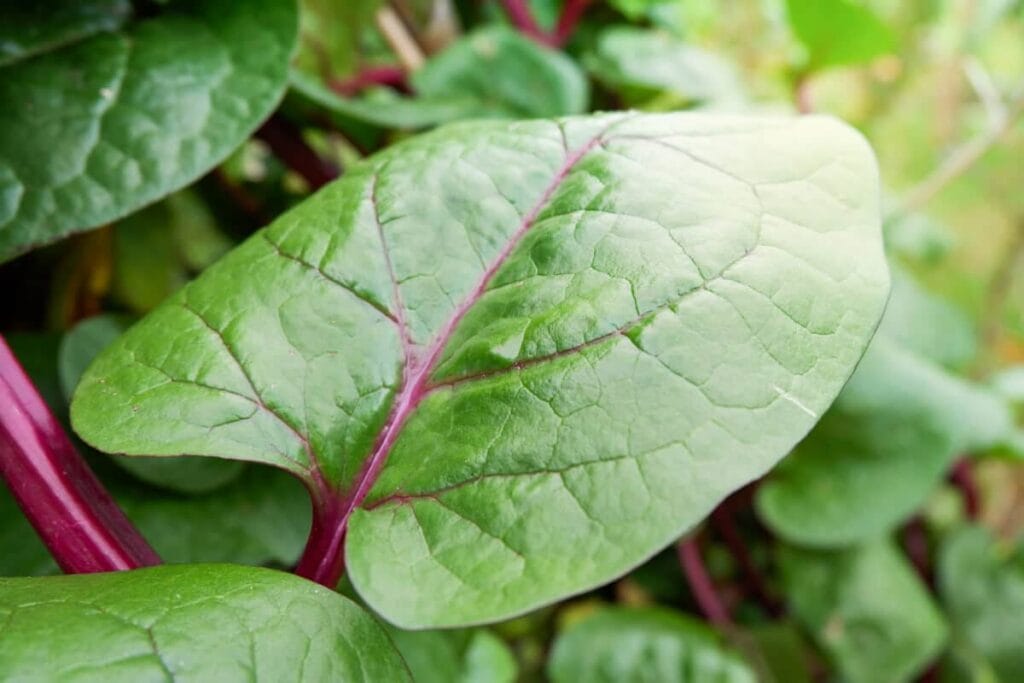[ad_1]
When hotter summer season temperatures trigger lettuces, kale and spinach to bolt and develop bitter, it’s time to interchange them with heat-loving, easy-to-grow Malabar spinach.
Though not technically a spinach, Malabar leaves can be utilized rather than conventional spinach, and make a beautiful, vining edible with vivid fuchsia stems and flowers.
What’s Malabar Spinach?
Often known as climbing spinach, Indian spinach, vine spinach, or Ceylon spinach, Malabar spinach isn’t a real spinach, however its leaves look and style loads just like the acquainted inexperienced leafy vegetable. The darkish inexperienced, shiny, heart-shaped leaves are thick and semi-succulent with a mucilaginous texture.
Malabar spinach is a member of the Basellaceae household. Basella alba is the inexperienced leaf selection and Basella rubra has purplish stems and leaves. Malabar spinach is native to India, and is in style as a leafy inexperienced in China, Africa, Southeast Asia, Indonesia, New Guinea, and India.
The best way to Plant Malabar Spinach
Whereas the darkish inexperienced leaves resemble these of spinach, Malabar spinach is a vine that thrives in sizzling temps, even exceeding 90 F. (32 C.) It’s often grown as an annual, however simply grows like a perennial in areas which are frost free. Actually, it does so nicely in sizzling climates, and spreads it seeds so prolifically, it may develop into invasive when you aren’t cautious.
Simply two crops are adequate to supply loads of leafy greens for many households via the summer season and fall rising season.
Soil Preparation for Malabar Spinach
Malabar spinach grows nicely in quite a lot of soil circumstances however prefers a moist, fertile soil with loads of natural matter, and a barely acidic soil pH of between 6.5 and 6.8. It’s going to additionally develop nicely in pots, so long as the potting soil is extremely fertile and well-draining.
Malabar spinach may be grown in partial shade, but it surely prefers sizzling, humid temperatures and full solar.
Associated
Planting Malabar Spinach
Malabar spinach may be grown from both seeds or cuttings. It may be planted in USDA zone 7 or hotter, and actually wants warmth to develop, so wait to sow or transplant till the soil has warmed and there’s no probability of frost.
Sow Malabar spinach seeds ¼ inch deep, two to a few weeks after the final frost date. When you reside in a colder zone, begin the seeds indoors in pots set on a heated rising mat, about six weeks earlier than the final frost. Germination requires about three weeks with soil temperatures between 65-75 F. (18-24 C). Soaking the seeds in water in a single day earlier than planting them will assist germination.
To propagate Malabar spinach from a chopping, trim a bit from the tip of one of many stems. Minimize slightly below a rising node, trimming stems to 5-6 inches in size. Rooting hormone can be utilized when you’d like, or you may place the chopping instantly into well-draining soil. Cuttings can be rooted in water.
Skinny or transplant your seedlings or cuttings to a couple of foot aside.
Fertilizing Malabar Spinach
When you have already combined in compost or aged manure throughout your soil prep, you’ll solely have to side-dress your Malabar spinach crops with fertilizer through the rising season. You want an natural method that’s excessive in nitrogen and decrease in phosphorus and potassium.
It’s best to apply fertilizer to the soil round your crops roughly as soon as a month all through the rising season.
Particular Suggestions for Rising Malabar Spinach
Water Persistently
Malabar spinach is a tropical plant that wants constant moisture all through the rising season. Permitting the soil to completely dry out will encourage flowering, which is able to flip the leaves bitter. Every day, timed drip irrigation or lots of rain are strongly advisable. Mulching is advisable to maintain the soil moist.
Trellis the Vines
This fast-growing plant is a vigorous, twining vine that may develop as much as 10 ft lengthy as an annual, and even longer as a perennial in heat climates. Malabar spinach will must be trellised or given one thing sturdy to climb.
Grown as a decorative edible, the enticing vines can be skilled to climb over doorways, fences, pergolas, and so on. To prune Malabar spinach, merely minimize the stems again. Aggressive pruning will sometimes simply make the plant bushier.


Companion Crops for Malabar Spinach
Malabar spinach is a wonderful companion for asparagus, brassicas, eggplant, leeks, lettuce, peas, radishes, and significantly strawberries. They won’t do nicely if they’re planted beside potatoes.
Malabar Spinach Pests and Illnesses
Malabar spinach is comparatively care-free and never sometimes bothered by pests and illnesses, however you may see the next points:
Leaves curl underneath and develop into deformed and yellowish.
Aphids are tiny, oval, and yellowish to greenish pear-shaped bugs that colonize on the undersides of leaves. They go away behind sticky excrement known as honeydew which may flip right into a black sooty mould. Use insecticidal cleaning soap.
Small holes or pits within the leaves.
Flea beetles are tiny pests which are darkish in shade, with a shiny, iridescent carapace. They leap like fleas when disturbed, incomes the title flea beetles. Use floating row covers; mulch deeply round crops. Use diatomaceous earth or Neem oil to manage the inhabitants.
Leaves with giant, easy chew holes.
Slugs and snails ought to be hand-picked with gloved arms and drowned in a pail of water. You can even simply lure them into traps made by inserting an inch of beer in a small open container, and sinking it as much as its rim in soil or mulch. You can even use copper tape round your backyard beds, or diatomaceous earth to maintain them away out of your crops.
Plant seems to be stunted with yellow leaves.
Root knot nematodes are Malabar spinach crops’ one true nemesis. When you have them, destroy affected crops and discover a new location to plant your Malabar spinach.
Leaves with purple spots and holes.
Cercospora beticola is a fungal illness that may have an effect on beets, spinach, Swiss chard and Malabar spinach. Use drip irrigation, crop rotation, and take away and destroy contaminated leaves to stop the illness from spreading. A very good-quality liquid copper fungicide, or an answer of Bacillus amyloliquefaciens utilized to the leaves can deal with the illness organically.
The best way to Harvest and Retailer Malabar Spinach
You may harvest the leaves of Malabar spinach at any level through the rising season, as soon as the vines have not less than 8-10 leaves. There’s no particular trick to harvesting Malabar spinach: Simply snip tender, younger leaves with scissors or a knife. Minimize leaves from the skin first, being positive to depart not less than 6 leaves behind to permit the plant to regrow.
Malabar can deal with aggressive pruning and actually, selecting giant quantities of the plant will solely encourage it to develop into bushier. When you don’t have the room for a prolonged vine, simply harvest regularly.
Flowers will make the leaves a bit bitter, and can produce a profusion of darkish purple berries which are mildly candy with massive seeds inside. The berries are extremely pigmented, and can be utilized as meals coloring or egg dye.
Malabar spinach is greatest eaten contemporary. After harvesting the leaves or stems, use them instantly or retailer them within the fridge for 2-5 days. When you have a really ample harvest, you may blanch the leaves after which freeze them.
The best way to Save Malabar Spinach Seeds
Malabar spinach will die out within the winter, however usually the seeds (if left on the vine) will fall to the bottom and sprout the next spring by the handfuls. Actually, in case you have gentle winters, you might discover Malabar spinach turns into your largest backyard weed!
To reap the seeds for future planting, twist the berries off the vine when they’re deep purple to virtually black in shade. Then you are able to do certainly one of two issues:
- Place the berries in a bowl with soapy water or in a sieve underneath working water, and rub them till the fruit is faraway from the seeds. Use waterproof gloves as a result of the juice can badly stain your arms. Place the cleaned seeds on a plate or towel and permit them to dry fully.
- Dry the berries entire, and plant them the next yr. This can take for much longer to dry than the primary methodology.
Use air-tight containers, and retailer in a cool, darkish place or the fridge. The much less moisture and daylight there may be the higher the seeds will preserve. Relying on how nicely they’re saved, dried Malabar spinach seeds can stay viable for as much as three years.


The best way to Use Malabar Spinach
Each the leaves and stems of Malabar spinach may be eaten uncooked in a inexperienced salad, or steamed, sauteed, or boiled like common spinach. The leaves and stems may be harvested and eaten all through the rising season, however as soon as the crops begin flowering, the leaves develop into bitter.
Malabar spinach is scrumptious in soups, stir-fries and curries, and it holds up higher than common spinach throughout cooking as a result of it doesn’t wilt as a lot. You need to use Malabar spinach in virtually any recipe that calls for normal spinach.
Due to its mucilagenous nature, Malabar spinach can be used to thicken soups and stews. Some folks don’t respect the considerably slimy texture of the cooked leaves (paying homage to cooked okra or chia seeds). This mucilage is a superb supply of soluble fiber, very similar to the pectin in apples.
Malabar spinach is excessive in beta carotene, lutein, Vitamin C, folate, and manganese. It’s also a very good supply of B nutritional vitamins, calcium, magnesium, and iron.
Malabar Spinach Recipes
[ad_2]
Source link

